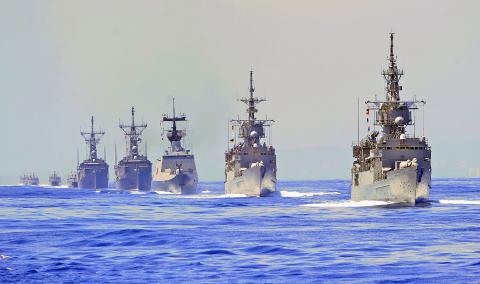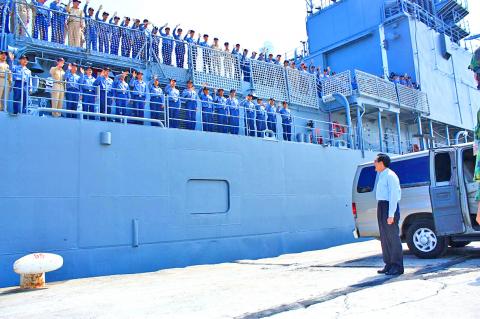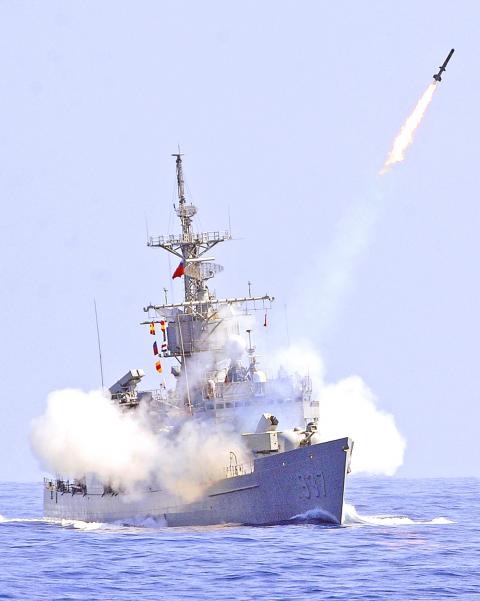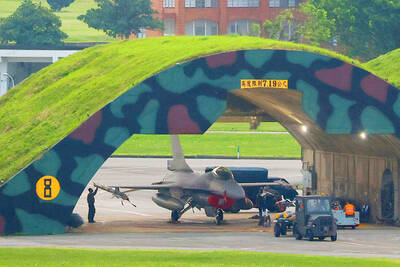The navy put on a show of combat readiness and live fire drills on the third day of the annual Han Kuang military exercises, in the biggest naval drill in 25 years.
Twenty-one ships, marine patrol aircraft and F-16 and F-5 jets took part in the exercises held off the coast of Yilan and Hualien counties, watched by President Ma Ying-jeou (馬英九).
A separate drill, involving 67 vessels, was conducted off the southwest coast.

Photo: Liao Chen-huei, Taipei Times
The vessels taking part in the exercise off the east coast included Keelung-class destroyers, Chengkung-class frigates, a Lafayette-class frigate, Knox-class frigates, Kuang Hua VI-class missile boats and a submarine, navy spokesman Vice Admiral Wen Cheng-kuo (聞振國) said.
More than 2,000 navy personnel took part in the exercise, which involved live firing of depth charges, 76mm naval guns, 5-inch guns and other weaponry to fend off attacks by enemy forces, he said.
The maritime drills were meant to simulate intrusion into Taiwan’s waters by Chinese forces, and show that the navy can repel such attacks.

Photo: Courtesy of Huadong Defense Command
Asked how the drill would prepare for the possibility of a conflict in waters around the Diaoyutai Islands (釣魚台), which are claimed by Taiwan, China and Japan —where they are known as the Senkaku Islands — Wen said the ships from the naval bases in Suao (蘇澳), Yilan County, and Keelung (基隆) would engage the enemy.
Ma boarded the Tsoying (左營艦), a 9,525-tonne Keelung-class destroyer at the Suao port.
He watched the drill from aboard the destroyer, which sailed more than 15 nautical miles (28km) offshore for a series of naval maneuvers, and was later joined by other vessels in battle fleet formation.

Photo: Liao Chen-huei, Taipei Times
The Tsoying returned to shore, accompanied by another Keelung-class destroyer, the Makong (馬公艦), and docked in Hualien’s port early in the afternoon.
It was the first time Ma had watched a maritime drill held in waters off Taiwan from aboard a ship since he became president in 2008.
The four-hour drill started with air, surface and submarine attacks by the simulated enemy. The navy responded by deploying various warships to counter the attacks. F-16 jets were used to simulate enemy aircraft and launch a missile attack, which the navy responded to with anti-missile maneuvers.

Photo: AFP
The navy and air force conducted a joint anti-submarine operation, with P-3C aircraft and an S-70C helicopter deployed to identify the enemy submarine and force it to the surface.
The drill marked the first time a P-3C, of which Taiwan took delivery from the US last year, has been used in a Han Kuang drill, Ministry of Defense spokesman Major General David Lo (羅紹和) said.
The Ministry of National Defence bought 12 P-3Cs and the final batch is scheduled to be delivered by the end of next year.
After the submarine maneuver, the navy ships launched a joint attack, firing their guns at a simulated target.
Yesterday’s live fire drill concluded with an F-16 firing an AIM-9P4 Sidewinder missile at the simulated enemy approaching from the sea.
Two more live fire drills are scheduled to be held today in waters off Penghu and at a military training base in Pingtung County.

MISINFORMATION: The generated content tends to adopt China’s official stance, such as ‘Taiwan is currently governed by the Chinese central government,’ the NSB said Five China-developed artificial intelligence (AI) language models exhibit cybersecurity risks and content biases, an inspection conducted by the National Security Bureau (NSB) showed. The five AI tools are: DeepSeek, Doubao (豆包), Yiyan (文心一言), Tongyi (通義千問) and Yuanbao (騰訊元寶), the bureau said, advising people to remain vigilant to protect personal data privacy and corporate business secrets. The NSB said it, in accordance with the National Intelligence Services Act (國家情報工作法), has reviewed international cybersecurity reports and intelligence, and coordinated with the Ministry of Justice Investigation Bureau and the National Police Agency’s Criminal Investigation Bureau to conduct an inspection of China-made AI language

BOOST IN CONFIDENCE: The sale sends a clear message of support for Taiwan and dispels rumors that US President Donald Trump ‘sold out’ the nation, an expert said The US government on Thursday announced a possible sale to Taiwan of fighter jet parts, which was estimated to cost about US$330 million, in a move that an expert said “sends a clear message of support for Taiwan” amid fears that Washington might be wavering in its attitude toward Taipei. It was the first announcement of an arms sale to Taiwan since US President Donald Trump returned to the White House earlier this year. The proposed package includes non-standard components, spare and repair parts, consumables and accessories, as well repair and return support for the F-16, C-130 and Indigenous Defense Fighter aircraft,

CHECKING BOUNDARIES: China wants to disrupt solidarity among democracies and test their red lines, but it is instead pushing nations to become more united, an expert said The US Department of State on Friday expressed deep concern over a Chinese public security agency’s investigation into Legislator Puma Shen (沈伯洋) for “secession.” “China’s actions threaten free speech and erode norms that have underpinned the cross-strait ‘status quo’ for decades,” a US Department of State spokesperson said. The Chongqing Municipal Public Security Bureau late last month listed Shen as “wanted” and launched an investigation into alleged “secession-related” criminal activities, including his founding of the Kuma Academy, a civil defense organization that prepares people for an invasion by China. The spokesperson said that the US was “deeply concerned” about the bureau investigating Shen

LIMITS: While China increases military pressure on Taiwan and expands its use of cognitive warfare, it is unwilling to target tech supply chains, the report said US and Taiwan military officials have warned that the Chinese People’s Liberation Army (PLA) could implement a blockade within “a matter of hours” and need only “minimal conversion time” prior to an attack on Taiwan, a report released on Tuesday by the US Senate’s China Economic and Security Review Commission said. “While there is no indication that China is planning an imminent attack, the United States and its allies and partners can no longer assume that a Taiwan contingency is a distant possibility for which they would have ample time to prepare,” it said. The commission made the comments in its annual